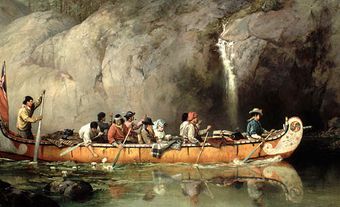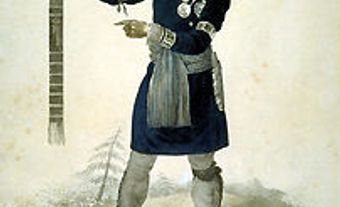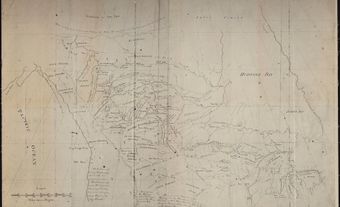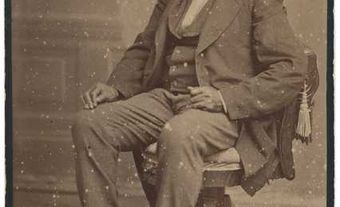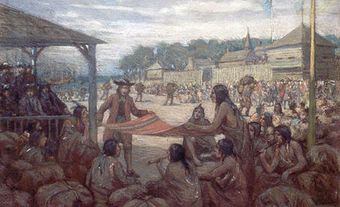Michel Cadotte, pioneer fur trader, interpreter, mediator (born 22 July 1764 in Sault Ste. Marie, Michigan; died 8 July 1837 in La Pointe, Wisconsin). Cadotte established a large, successful fur trade along the south shore of Lake Superior, which covered present-day northern Wisconsin and extended into parts of northern Minnesota. Half French Canadian and half Ojibwe, he endeared himself to the Indigenous people of the area by marrying Ikwesewe, the daughter of an Ojibwe chief, and by his compassionate understanding of Indigenous ways. These factors allowed Cadotte to gain a monopoly on the fur trade with the Indigenous peoples of the area.

Early Life
Cadotte’s father and grandfather were fur traders, who lived in Sault Ste. Marie. The fur-trading outpost was part of France’s North American empire. Cadotte’s father, Jean-Baptiste Cadot (the name later became Cadotte), married Athanasie, an Ojibwe woman who was related to chief Madjeckewiss. Athanasie frequently accompanied her husband on his distant fur-trading trips throughout the region. Jean-Baptiste and Athanasie had two daughters and two boys, Jean-Baptiste Jr. and Michel.
Michel Cadotte spent his early childhood in and around Sault Ste. Marie, where he undertook his initial schooling. Like his older brother, he was sent to Montreal, where he completed a liberal education. When he returned to Sault Ste. Marie, he became an assistant to his father in the fur trade. By the time he was 20 years old, Michel spent the winters among his Indigenous relatives at the head of the Chippewa River. In 1784, he started a trading post at on the Namekagon River and traded with the Indigenous peoples of the upper Mississippi River.
It may have been at this post that Cadotte first met his future wife, Ikwesewe (“Traveling Woman”), who was four years older than him. Ikwesewe was the daughter of an Ojibwe chief, White Crane, also known as Waubujejack. By 1787, Michel and Ikwesewe were living together as husband and wife in accordance with Ojibwe customs. The first of several children was born there in September of that year.
Cadotte and Ikwesewe continued to live and trade on the Chippewa River. Their existence was threatened a few years later by Sauk and Fox warriors from southern Wisconsin. The warriors challenged the Cadottes and their Ojibwe trading partners for control of the fur-rich region. After a tough fight, the Cadottes and their allies drove off the invaders, who never returned to that part of northern Wisconsin.
Independent Fur Trader
Sometime around the turn of the 19th century, Michel and Ikwesewe established a permanent trading post and their family home at a new location. It was on the southern tip of Moningwunakauning, a small 109-square-kilometre island, some 22.5 kilometres long by 5 kilometres wide. The island is located off the southern shore of Lake Superior, near its western end and is the largest of 22 islands in an archipelago known as the Apostle Islands. Ikwesewe’s father, White Crane, was the hereditary chief of the Ojibwe on the island and the immediate area. Eventually, White Crane’s family deeded the land for the Cadotte property to Michel and Ikwesewe. Later, about mid-19th century, the island was named for Ikwesewe’s married Christian name, Madeline.
The strategic site of the island and his relationship to Ikwesewe allowed Cadotte to establish a fur trade over a wide area. He established several inland trading posts that were run by his employees and relatives. He became one of the most profitable independent traders in the region. His success was broken by the incursions of traders of the North West Company (NWC), however, and he began to trade exclusively with that company in 1798. Cadotte was still an independent fur trader, but who had agreed to sell his furs only to the NWC, buy his supplies from them, and operate only with the areas the company assigned to him.
In 1806, a new fur-trading company, the Michilimackinac Company, concluded an agreement with the NWC that established the boundaries within which each firm could operate. As much of Cadotte’s territory was in the area controlled by the Michilimackinac Company, a clause in the agreement required the new company to assume his contract with the NWC.
The American Fur Company
In 1811, America’s first multimillionaire, John Jacob Astor, negotiated with the Michilimackinac Company to establish a new company that would operate only in the United States. The War of 1812 interrupted these negotiations, but when it ended in 1814, Astor succeeded in convincing the government to make it illegal for non-US citizens to trade in furs in the United States. Cadotte purchased American citizenship for $5 and began to trade with the American Fur Company.
In 1823, Cadotte sold his interests in his fur trading operation on Madeline Island to two of his sons-in-law and retired, although he still had a license to trade furs. In 1830, Michel and Ikwesewe were married in a Catholic church, more than 40 years after they were joined in the traditional Ojibwe way. This was likely because of a local judicial decision to invalidate marriages conducted only in the Indigenous way.
Death
Cadotte died impoverished at La Pointe, Wisconsin, in 1837. Ikwesewe lived into her 80s or 90s and is also buried at LaPointe.
Did You Know?
Madeline Island Museum is now located on the site of the old American Fur Company building at LaPointe. Visitors can still see the original trading post at the southern tip of Madeline Island.

Recognition
During his lifetime, Cadotte was much-loved and respected by the Indigenous peoples of the region and became known as Kechemeshane, or Great Michel. He was often consulted to resolve disputes and became the final court of appeal. He was also known as “Kind Hearted Michel Cadotte.”
In 1865, Robert Marriner built a dam and sawmill at Cadotte Falls on the Yellow River in Wisconsin and laid out a settlement, which became known as Cadott after the fur-trading family. In 1974, the Cadott Lions Club erected an historical marker to “The Cadotte Fur Traders” in Cadott. It honours Jean-Baptiste Cadotte and his sons, Jean-Baptiste Jr and Michel, who “became influential as merchants, interpreters and mediators; and were considered by the Ojibways as ‘Chiefs.’” The next year, another plaque was erected beside the statue, marking the site of the Cadotte trading post established by Michel Cadotte.

 Share on Facebook
Share on Facebook Share on X
Share on X Share by Email
Share by Email Share on Google Classroom
Share on Google Classroom

